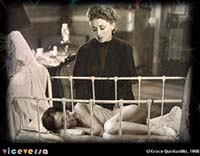
Born in Mexico City in 1967
In 1988 Grace Quintanilla takes a painting and sculpting apprenticeship with Luis López Loza. In 1990 moves to Edinburgh to study drawing and painting at the Edinburgh College of Art.
While in Scotland, she is a member of the Edinburgh Printmakers Workshop and the Underwired women artists' group. Her paintings and prints are shown in several exhibitions in Scotland and England. In 1993 she attends an animation course at the Edinburgh Film Workshop Trust. In 1994 she moves to Dundee to pursue a postgraduate course on Electronic Imaging at the School of Television and Imaging, Duncan of Jordanstone College of Art, University of Dundee.
In 1996 she returns to Mexico where she is awarded the second prize of the National Competition of Cultural Television for her documentary series entitled Aventurera, a three program documentary of cabaret women's life in Mexico, the programs have been regularly broadcasted on television in Mexico as well as in Argentina. On the same year, her video Mambo Queen wins the first prize at the Reel to Real Festival in Glasgow, Scotland. In 1997-1998 holds grant from the National Arts Council (FONCA) to produce an interactive CD-ROM entitled Viceversa, a multimedia documentary of the life of two old actors.
Her video work is shown in festivals around Europe, South America and the United States such as Video Positive, Liverpool, England (1995). AVE Festival, Arnhem, Holland (1995). British Short Film Festival, London (1995). Fotofeis Festival Glasgow, Scotland (1996). Festival de Cinemá de Douarnenez, France (1996). Fri Art Festival, Friborg, Switzerland (1996). Mexican Video Artists Festival, Boston, USA (1997). Mix Festival touring exhibition in Mexico, Portugal and Brazil (1997-1998). In Sync Festival touring exhibition, New York City, Venezuela, Argentina and Mexico City (1998).
Conceptual Description
Viceversa presents the story of two characters, a man and a woman who have been actors, dancers and comedians in popular forums of Mexico such as carpas, cabarets, cinemas and radio.
The aim of the project is to experiment with the boundaries of traditional documentary in which the narrative structure is conceived in a linear way and predetermined by the director.
Viceversa talks about the life of Beto and Chelo Cobo who are brother and sister. Children born from a couple of actors, they took acting and dancing as their career before they could decide otherwise.
Their story is presented through their bodies. The histories they present were triggered by remembering their life through their bodies.
They were given recent photographs of their body and were asked to write and talk about them in a retrospective way.
Once I had the written testimonies I was able to "illustrate" their words not only with album photographs and existing iconography, but, when possible, with video footage and manipulated images, in such a way that I could also represent their fantasies and fears.
The general structure of Viceversa is divided in two main sections:
- The past and the present in which they talk about their childhood and their career.
- The depths in which they talk about their personal thoughts, dreams and memories.
The user will access the first section automatically. The past can be seen by clicking on their photo-albums and their present by clicking parts of their faces.
In order to access the second section, the user must have visited their whole past (albums) and all their present (eyes, nose and mouth) first. This second section can be visited by clicking on the boxes behind the actors.
Once in the depth section, it is possible to know Chelo and Beto from the front, the back, from far away and close by clicking on the boxes lying on the shelves of the room. In this section, the user constructs their history by "de-constructing" their body.

